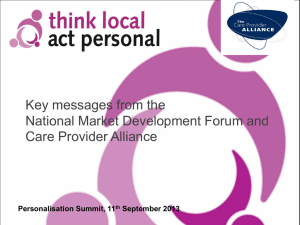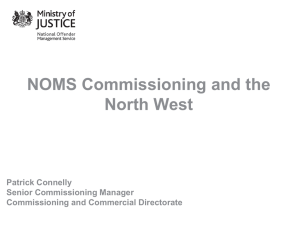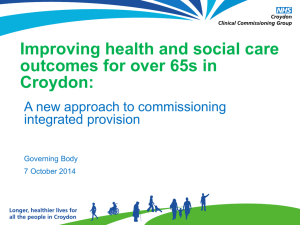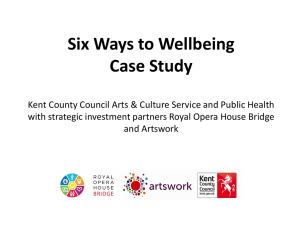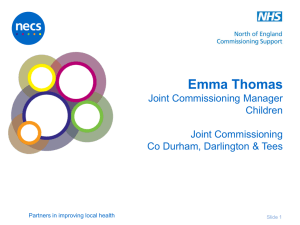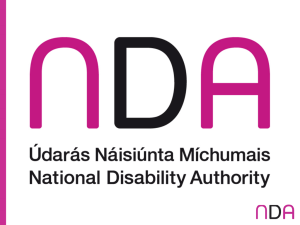Individual Commissioning
advertisement
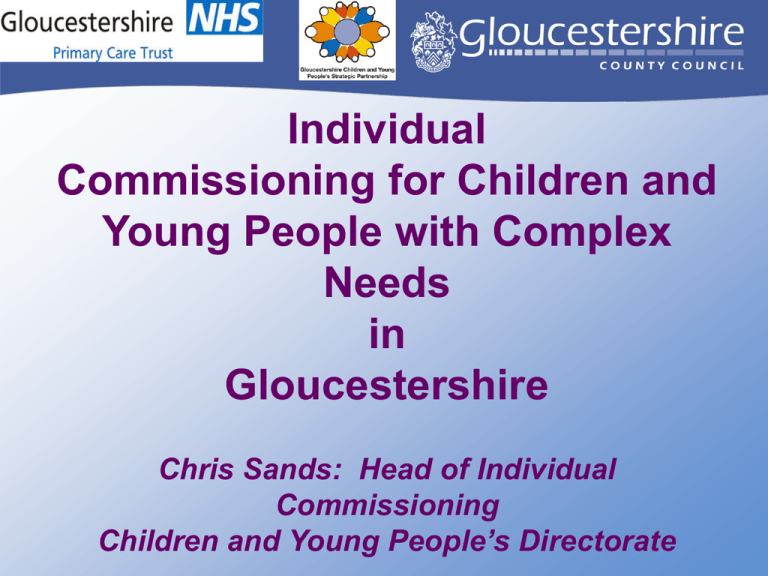
Individual Commissioning for Children and Young People with Complex Needs in Gloucestershire Chris Sands: Head of Individual Commissioning Children and Young People’s Directorate Placements Feedback Special Educational Needs Support Services Learning Points Budget Holding Lead Professional Pilot (Children in Care) Outcomes Children and young people with Complex Needs ……have a number of discrete needs – • e.g. relating to their health, education, welfare, development, home environment • Require additional support from more than one agency / service sector / system. •Their needs are often chronic and may be life-long. •These different needs tend to interact, exacerbating their impact on the child's development and well-being. Typically, they may have….. • A spectrum of need which has been sustained for at least 6 months (and is likely to be ongoing); • Needs falling at the severe/profound end of a spectrum of intensity; • Needs falling across at least two of the areas below: – Acute and/or chronic medical difficulties, – Multiple and profound physical and/or sensory impairments, – Behaviour problems which are often challenging, – Significant Learning and/or Language difficulties, and/or disabilities, – Parenting and/or attachment/social needs. • Intensive ongoing involvement of at least two agencies / service sectors, usually drawn from: – Therapy services – Specialist Educational Services – Nursing and Medical Services – Social Care Services (core teams or specialist personnel) – Mental Health Services Where we were……a bit of history… •Poor outcomes •Escalating spend •Inefficient processes •Lack of customer focus •Future predictions The Complex Needs Strategy Complex Needs Strategy (excerpt) Revise and redesign the commissioning process in order to improve processes and decision-making, broaden choice of placement options, ensure an outcomesfocussed approach based on individual needs, and ensure that these needs are met by effective quality providers at reduced levels of cost. Since then…………… Commissioning has really taken off…. Why? Clear direction from DCSF, the CSP + Ofsted Inspections Move away from ‘what we have/always had’ to what we and our customers need/planning for the future/trends/patterns etc …..Its our framework for planning all services for dynamic future proofing Commissioning Cycle Analysing Planning (e.g. OPS; CYPP NA; (e.g. CYPP; Commissioning Commissioning Plans NA) Plans; evidence/’research’) Reviewing Doing (e.g. CYPP; Contracts/SLAs) (e.g. Tendering/Contracting Service Improvement &/or Development Plans) (DCSF) (CSP) Different levels of commissioning •Strategic •Local My focus today •Individual Sounds simple... Levels of commissioning GLOUCESTERSHIRE CONFERENCE GSP Gloucestershire Strategic Partnership CYPSP BOARD and EXECUTIVE GROUP Countywide strategic commissioners eg PCT and GCC COMMISSIONING BOARD Schools Forum Commissioning team DISTRICTS NETWORK (Chairs of the 6 LSP CYP Thematic sub groups and district officers) 6 LSPS (Local Strategic Partnerships) CYP Local Strategic Partnerships key Countywide strategic commissioners District/locality commissioners Extended services clusters CYP ‘hubs’ Locality Managers Individualised budgets through Lead Professionals Providers of services Children and families in Gloucestershire Commissioning family/individual level Officer support money need Individual Commissioning Professional Filter – what happens now Moving from this Individual Commissioning Where we’re going -Citizenship Model To this Resource Allocation System…… Individual Commissioning Key Features/principles of the Gloucestershire Commissioning Model Needs led, outcome focused Promotes choice Accountability and review Local services Creativity, flexibility Transparency, clear processes and timescales Value for money Empowers and engages yp, their families/carers Objectives: Improved, managed outcomes relating to ECM Improved stability and placement choice Effectively commissioned services through pre-qualified lists (fostering, residential, SEN) Increased local service provision Increased accountability for service outcomes Empowerment of young people and carers in decision making processes Reduced bureaucratic processes and release time back into frontline working Link with and build upon experiences of individual budgets for children in care and children and young people with disabilities Join up the commissioning and individual budget processes (BHLP and the Resource Allocation System) Where we are up to……. •Individual Commissioning Services Team •Mainstream Children’s Homes….closed – all children’s homes services individually commissioned •Fostering: •Service of excellence •Business model •Level playing field (12+) •28 day contract •Target for 85% in fostering placements •Special School and SEN process trials •Budget Holding Lead Professionals pilots •Support Services accreditation Process examples Service Commissioning Individual outcome focused commissioning profile completed (with parents and yp) ICST screen against priorities ICST Quality Assurance function Expressions of Interest from Partner Providers (pre-qualified providers) Anonymised data 5 working day turnaround X Tribunals 7 Parental pref…. Social Worker/Lead Professional grades (with parents and yp) Negotiation with partner providers ranked 1&2 Needs/Outcomes form part of YP’s review Contracts based on clear service/outcomes provision Needs/outcomes to IRO Service Special Educational Needs Trial Stat assessment request or review indicates complex needs Multi-agency outcomes meeting held: identifies and agrees need, outcomes and challenges Commissioning form completed by LP, agreed by parents and professionals Decision re. extra resources/external placement LP, professionals and parents grade responses and undertake visits Contract issued and placement begins Review of outcomes Aims of the BHLP pilots The BHLP pilots aim to: Involve young people and parents in decisions about what they need and how best to support them Ensure children, young people and families get the services they need when they need them. Reduce overlap and inconsistency and poor engagement, thus reducing the costs per “episode” of intervention. BHLP Children in Care Pilot Workstreams: •Children waiting permanency •Educational achievement •Young people with substance misuse issues •Yp in our children’s homes •Children and young people’s participation BHLPs - How they work…… Common Assessment (CAF) Analysis/PEP completed with parent, young person, relevant professionals Allocate budget if required Complete support plan with young person/parents Needs and outcomes identified Agree Lead Professional if not already identified Access existing services or commission direct Review outcomes One of our big questions and challenges… Why go out of county? What more could we do in-county? How can we make better use of our own resources? Special School Trials Emerging needs….. Creative & Flexible approach Not just ‘education’ Costs inevitable… Accreditation of ‘non-trad’ providers Use BHLP principles Local support services Individual Commissioning: Have we got it right? Proof of the pudding……. Benefits Realisation Improved stability/choice/ matching Reduction in yp placed out of county Increased Local provision Increased involvement in decisions and process Sufficiency Promotes roll out of BHLP Improved Market engagement Reduced overall costs compared with pre-ICST Increased accountability Commissioning Learning Points and feedback IFAs: - comprehensive information able to meet timescales ECM framework helpful in matching outcomes led supports matching a plan already to roll positive way forward 100% good/very good/excellent SWs: - takes more time than want to spend QA function presents a challenge timescales difficult to determine re outcomes difficult if not know child (when an emergency) ECM focus good 55.5% good/excellent. 33% average. 11.5% poor BHLP (Children in Care Learning Points) Social work practice issues: •Raises questions about what the role of the social worker is – commissioner a new concept •Meaningful relationships with young people •Challenges the culture of the ‘expert’ model •Moving from systems and process approach to needs led •Corporate parenting aspirations BHLP (Children in Care Learning Points) cont.. Engagement with young people issues: •Greater participation in the care planning process •To feel they are important and that they matter •A chance to talk about their day to day needs with someone with whom they have a meaningful relationship Commissioning feedback Young People: my choices were considered yes: definitely successful Right Choice? Choice? offered choice of two placements yes: happy and settled in placement two intros and enough notice Placement move? quite an achievement! ‘Just wanted to say that the process ran very sweetly. Many thanks to everyone for their part in finding the right placement. I have been impressed by the professional courtesy and support along the way. The process is a vast improvement (to past experiences) and really does help to focus on my child’s needs and outcomes’ Individual Commissioning: Have we got it right? …..we’re still learning and working on it!
